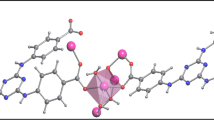Abstract
Reported here is a water-soluble ligand, N-(sulfoethyl)-iminodiacetic acid (H3SEIDA), used for the complexation of uranyl ions. A coordination compound composed of uranyl cation and N-(sulfonatoethyl)-ammoniodiacetate (SEADA2−) zwitterion was synthesized from an acidic aqueous solution. This compound features a 2D undulating fes (4.82) coordination layer that is stacked and linked by hydrogen-bonding interaction to form a 3D supramolecular framework with a 1D larger-cycle channel. Thermal analysis demonstrates the relatively weak bonding between uranyl cation and SEADA2− zwitterion. The monomeric uranyl-based fluorescence emission is red-shifted by about 5 nm compared to that of uranyl nitrate hexahydrate. The hydrothermal synthesis of this uranyl compound was successfully applied to the sequestration of uranyl ions.
Similar content being viewed by others
References
Wang KX, Chen JS. Extended structures and physicochemical properties of uranyl-organic compounds. Acc Chem Res, 2011, 44: 531–540
Andrews MB, Cahill CL. Uranyl bearing hybrid materials: synthesis, speciation, and solid-state structures. Chem Rev, 2013, 113: 1121–1136
Nash KL, Horwitz EP, Diamond H, Rickert PG, Muntean JV, Mendoza MD, Di Giuseppe G. Selective separation of uranyl ion from tru’s in a combined solvent extraction process using tetrahydrofuran-2,3,4,5-tetracarboxylic acid. Solvent Extr Ion Exch, 1996, 14: 13–33
Morss LR, Nash KL, Ensor DD. Thermodynamics of lanthanide and uranyl complexes with tetrahydrofuran-2,3,4,5-tetracarboxylic acid (THFTCA). J Chem Soc, Dalton Trans, 2000: 285–291
Sather AC, Berryman OB, Rebek Jr J. Selective recognition and extraction of the uranyl ion. J Am Chem Soc, 2010, 132: 13572–13574
Riisiö A, Väisänen A, Sillanpää R. Uranyl complexes of alkylbridged ditopic diaminotetraphenol ligands and their use as uranyl ion extractors. Inorg Chem, 2013, 52: 8591–8600
Tokunaga TK, Kim Y, Wan J. Potential remediation approach for uranium-contaminated groundwaters through potassium uranyl vanadate precipitation. Environ Sci Technol, 2009, 43: 5467–5471
Tokunaga TK, Kim Y, Wan J, Yang L. Aqueous uranium(VI) concentrations controlled by calcium uranyl vanadate precipitates. Environ Sci Technol, 2012, 46: 7471–7477
Rao L, Garnov AY, Jiang J, Di Bernardo P, Zanonato P, Bismondo A. Complexation of uranium(VI) and samarium(III) with oxydiacetic acid: temperature effect and coordination modes. Inorg Chem, 2003, 42: 3685–3692
Di Bernardo P, Zanonato P, Bismondo A, Jiang H, Garnov AY, Jiang J, Rao L. Complexation of uranium(VI) with thiodiacetic acid in solution at 10–85 °C. Eur J Inorg Chem, 2006: 4533–4540
Liao ZL, Li GD, Bi MH, Chen JS. Preparation, structures, and photocatalytic properties of three new uranyl-organic assembly compounds. Inorg Chem, 2008, 47: 4844–4853
Zheng YZ, Tong ML, Chen XM. Synthesis, structure and photoluminescent studies of two novel layered uranium coordination polymers constructed from UO(OH) polyhedral and pyridinedicarboxylates. Eur J Inorg Chem, 2005: 4109–4117
Schlosser F, Kru1ger S, Rö1sch N. A density functional study of uranyl monocarboxylates. Inorg Chem, 2006, 45: 1480–1490
Videnova-Adrabinska V. Coordination and supramolecular network entanglements of organodisulfonates. Coord Chem Rev, 2007, 251: 1987–2016
Kläui W, Berghahn M, Rheinwald G, Lang H. Tris(pyrazolyl)methanesulfonates: a novel class of water-soluble ligands. Angew Chem Int Ed, 2000, 39: 2464–2466
Henge-Napoli MH, Archimbaud M, Ansoborlo E, Metivier H, Gourmelon P. Efficacy of 3,4,3-LIHOPO for reducing the retention of uranium in rat after acute administration. Int J Radiat Biol, 1995, 68: 389–393
Henge-Napoli MH, Ansoborlo E, Chazel V, Houpert P, Paquet F. Gourmelon P. Efficacy of ethane-1-hydroxy-1,1-bisphosphonate (EHBP) for the decorporation of uranium after intramuscular contamination in rats. Int J Radiat Biol, 1999, 75: 1473–1477
Xu K, Ge W, Liang G, Wang L, Yang Z, Wang Q, Hsing I, Xu B. Bisphosphonate-containing supramolecular hydrogels for topical decorporation of uranium-contaminated wounds in mice. Int J Radiat Biol, 2008, 84: 353–362
Uehara A, Kyuno E, Tsuchiya R. The chromium(III) complexes with β-aminoethylsulfonic-N,N-diacetic acid and aspartic-N,N-diacetic acid. Bull Chem Soc Jpn, 1969, 42: 2835–2840
Alexandrov EV, Blatov VA, Proserpio DM. A topological method for the classification of entanglements in crystal networks. Acta Cryst A, 2012, 68: 484–493
Denning RG. Electronic structure and bonding in actinyl ions and their analogs. J Phys Chem A, 2007, 111: 4125–4143
Liu G, Deifel NP, Cahill CL, Zhurov VV, Pinkerton AA. Charge transfer vibronic transitions in uranyl tetrachloride compounds. J Phys Chem A, 2012, 116: 855–864
Brachmann A, Geipel G, Bernhard G, Nitsche H. Study of uranyl(VI) malonate complexation by time resolved laser-induced fluorescence spectroscopy (TRLFS). Radiochim Acta, 2002, 90: 147–153
White KA, Chengelis DA, Zeller M, Geib SJ, Szakos J, Petoud S, Rosi NL. Near-infrared emitting ytterbium metal-organic frameworks with tunable excitation properties. Chem Commun, 2009: 4506–4508
Knope KE, de Lill DT, Rowland CE, Cantos PM, de Bettencourt-Dias A, Cahill CL. Uranyl sensitization of samarium(III) luminescence in a two-dimensional coordination polymer. Inorg Chem, 2012, 51: 201–206
Shu YB, Xu C, Liu WS. A uranyl hybrid compound designed from urea-bearing dipropionic dcid. Eur J Inorg Chem, 2013: 3592–3595
Thangavelu SG, Andrews MB, Pope SJA, Cahill CL. Synthesis, structures, and luminescent properties of uranyl terpyridine aromatic carboxylate coordination polymers. Inorg Chem, 2013, 52: 2060–2069
Contreras MA, Jones KM, Gedvilas L, Matson R. Preferred orientation in polycrystalline Cu(In,Ga)Se2 and its effect on absorber thinfilms and devices. In: 16th European Photovoltaic Solar Energy Conference and Exhibition Glasgow. Scotland, U.K., 2000
Ho NC, van der Pluijm BA, Peacor DR. Static recrystallization and preferred orientation of phyllosilicates: michigamme formation, northern michigan, USA. J Struct Geol, 2001, 23: 887–893
Zhang Z, Helms G, Clark SB, Tian G, Zanonato P, Rao L. Complexation of uranium(VI) by gluconate in acidic solutions: a thermodynamic study with structural analysis. Inorg Chem, 2009, 48: 3814–3824
Author information
Authors and Affiliations
Corresponding author
Electronic supplementary material
Rights and permissions
About this article
Cite this article
Shu, Y., Ju, Z., Zhang, H. et al. Complexation of uranyl ions by N-(sulfoethyl)-iminodiacetic acid: Hydrothermal synthesis, luminescence, and uranyl sequestration. Sci. China Chem. 58, 845–849 (2015). https://doi.org/10.1007/s11426-014-5243-3
Received:
Accepted:
Published:
Issue Date:
DOI: https://doi.org/10.1007/s11426-014-5243-3




